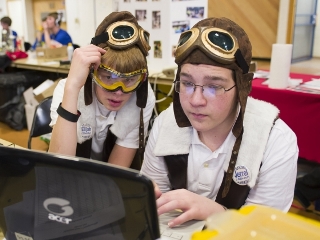Jan 31 2015
In a showcase complete with costumes, friendly rivalries and a healthy dose of budding engineering brainpower, hundreds of high school students from Montana, Wyoming, Idaho and Utah gathered at Montana State University on Friday for the FIRST Tech Challenge regional robotics championship.
 Team members of The 5024 Flyers from Twin Falls, Idaho, Elijah Hartney, left, and Jerrel Martin program their robot for autonomous operation before their event at the First Tech Challenge Regional Championship. The annual event draws teams from around the region for a two-day competiton at Montana State University in Bozeman. (MSU photo by Kelly Gorham)
Team members of The 5024 Flyers from Twin Falls, Idaho, Elijah Hartney, left, and Jerrel Martin program their robot for autonomous operation before their event at the First Tech Challenge Regional Championship. The annual event draws teams from around the region for a two-day competiton at Montana State University in Bozeman. (MSU photo by Kelly Gorham)
The event was the first of two days of youth robotics at MSU, with hundreds of Montana middle school students set to compete in the FIRST Lego League state championship on Saturday, also at MSU’s Shroyer Gymnasium. Lego League teams build the body of their robots out of Lego blocks. FIRST (For Inspiration and Recognition of Science and Technology) is an educational organization founded by Dean Kamen, inventor of the Segway scooter.
Initially started through the Montana Space Grant Consortium and now organized through the College of Engineering, MSU has been involved with the Montana FLL for 10 years. Rob Maher, professor and head of the Electrical and Computer Engineering Department at MSU, said it is an excellent way for MSU to reach out to K-12 students from all over Montana and encourage them to consider pursuing STEM (Science, Technology, Engineering, Mathematics) careers when they come to college.
“We want to give the participants a good experience in hopes that they gain the confidence to become MSU students one day,” Maher said. “In fact, we now have college students graduating from MSU with engineering degrees who got their start as sixth graders in the FIRST Lego League.”
Over the two days of robotics competition, MSU will host more than 1,000 students, said Alison Banfield, a systems administrator with MSU’s Electrical and Computer Engineering Department and the state coordinator for First Lego League.
Banfield said the competitions offer teams a big test of skills and systems they’ve been trying to perfect since the start of the school year.
The 5025 Flyers, one of several teams from Twin Falls, Idaho, have been working on their robot for three months. The group modified last year’s design with all-terrain wheels and new programming to adapt to this year’s game format, according to 14-year-old team member AC Palmer-Handley.
“It’s great to be here and learn about robots while hanging with friends,” Palmer-Handley said.
Both the high school and middle school teams are judged for their robot design and functionality. Teams win points when their robots successfully navigate problems, such as picking up balls and depositing them in cylinders of various heights. The 59 middle school teams in Bozeman for FLL are also judged on how well they complete a themed project and work as a team, Banfield said.
“It’s great to see because they may have some great engineering ideas,” Banfield said. “They may not always be able to get them to work on the playing field, but that doesn’t mean they aren’t viable ideas. It could be they just didn’t have enough time to work out all of the technical aspects. It’s not just about accumulating points, it’s also about learning.”